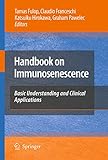Handbook on Immunosenescence : Basic Understanding and Clinical Applications / edited by Tamas Fulop, Claudio Franceschi, Katsuiku Hirokawa, Graham Pawelec.
Tipo de material: TextoEditor: Dordrecht : Springer Netherlands, 2009Descripción: recurso en líneaTipo de contenido:
TextoEditor: Dordrecht : Springer Netherlands, 2009Descripción: recurso en líneaTipo de contenido: - texto
- computadora
- recurso en línea
- 9781402090639
- R-RZ
Springer eBooks
1. Immunosenescence -- 2. Methods and models for studying immunosenescence -- 3. Cellular immunosenescence. 3.1 T cells. 3.2. B cells. 3.3 Neutrophils. 3.4 Antigen presenting cells. 3.5 NK and NKT cells. 3.6. Stem cells. 3.7. Genetics -- 4. Mechanisms 4.1. Receptors and signal transduction. 4.2 Mitochondria. 4.3 Proteasome. 4.4 Cytokines. 4.5 Neuro-endocrine-immune Network. 4.6 Thymus. 4.7. Inflammation -- 5. Clinical relevance in disease states. 5.1 Infection. 5.2 Autoimmunity. 5.3 Cancer. 5.4 Metabolic syndrome. 5.5. Neurodegenerative diseases. 5.6 Frailty. 5.7. Osteoporosis -- 6. Modulation. 6.1 Nutrition. 6.2. Lipids. 6.3. Vaccination. 6.4. Can interventions to influence immunosenescence succeed? Subject Index.
“Immunosenescence” is an imprecise term used to describe deleterious age-associated changes to immune parameters observed in all mammals studied so far. It represents a rapidly progressing science in the aging field, with a vertiginous volume of new data, knowledge and concepts concerning these changes. We are poised to be in a position to translate these accumulated data into the clinical setting via better understanding of the contribution of immunosenescence to age-associated pathologies, and their prevention by appropriate interventions. This authoritative handbook seeks to encompass the current state of our knowledge on the multitude of those changes to immunity related to aging, with contributions from experts in the research and clinical areas. This book therefore considers methods and models for studying immunosenescence; cellular immunosenescence of T cells, B cells, neutrophils, antigen presenting cells, NK, NKT and stem cells; genetics; mechanisms including receptors and signal transduction; mitochondria; proteasome; cytokines; neuro-endocrine-immune networks; inflammation; thymus; clinical relevance in disease states including infections, autoimmunity, cancer, metabolic syndrome, neurodegenerative diseases, frailty and osteoporosis; modulation by nutrition, lipids, vaccination and the question “can interventions to influence immunosenescence be realistically proposed based on our current state of knowledge?”
Para consulta fuera de la UANL se requiere clave de acceso remoto.


